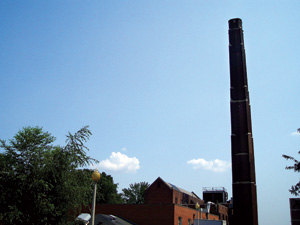 Sarah Klein
Sarah KleinIt looms behind the Danforth campus, on the sleepy street of Throop Drive. A tower, reaching for the clouds. The ing‚nues of Washington University may wonder what this giant edifice is – the power plant, surprisingly a historical part of the University, that’s what.
When entering the plant building, it looks like any other collection of Wash. U. offices. A step with one of the licensed operating engineers through the door to the plant itself, however, and one sees a convoluted world of pipes and boilers.
Actually, the power plant on Throop Drive is just one of several at Wash. U. There are five steam/hot water heating plants on the Danforth campus and one central hot water heating plant on the South 40. There is also a power plant on Wash. U.’s medical school campus.
The original central power plant (the one on Throop Drive) was built in 1900 to provide power and steam for heating the original University buildings, some of which were used in the 1904 World’s Fair, which was famous for introducing electrical power on a large scale, and the Olympics. The current power plant (replete with a smokestack) was built in 1924 and provided all the University’s power and steam for the next 24 years, until a Union Electric feeder was run on campus. The electric feeder provided for some of the growing University’s power needs until 1980.
Nowadays, however, the University depends on the local utility, Ameren-UE, for power. The power plants still provide steam for heating for the whole campus and for laboratory process equipment, like autoclaves, which are used to sterilize laboratory utensils with very high heat and steam. The plants also continue to get use in the summer, because the heat they produce can be used to temper the cold of air conditioning without reintroducing humidity. The plants previously burned coal to generate steam, but in 1993, the coal-fired boilers were replaced with natural gas and #2 fuel oil boilers, which is what the plants burn today.
The old central plant is also used today to teach students about boilers. Some engineering professors like to take their students on an informal tour through the power plant to see what large boilers look like and how they work.
The way the plants work today is pretty efficient. According to Ed Barry, manager of utility operations at the plants, Wash. U. must provide steam for itself. It is not available for purchase from the local utilities. The only other viable heating alternatives on a large scale would be direct heating with natural gas or electric heating, both of which, he says, are much less efficient in comparison to central heating. Also, we have several plants because, as Barry says, it is more efficient to generate low pressure steam from smaller plants around the area then to generate high pressure steam from single, large plant.
“The heat loss is less and the condensate return is better, resulting in greater efficiencies,” he said.
Also, while the materials burned by the plant might not have been so healthy for the environment before, changes to the plant have made it more environmentally friendly.
“The new natural gas and #2 fuel boilers produce significantly less [harmful] emissions than the coal boilers,” said Barry.
The plants and building systems on campus follow strict engineering guidelines that mandate maximum energy levels for lighting, heating and cooling systems. The plants and building systems also utilize many energy conservation practices to keep usage to a minimum.
Though some of the plants are old, they have been updated throughout the years. The main power plant and the South 40 plant (at Wohl Center) were updated in 1993. Other thermal plants were built around campus in 2001, 2002 and 2006, and another one is on the way, set to be operational in 2008.
The power plants have been and continue to be integral to heating at Wash. U. With a team of licensed engineers and new power plants appearing soon, students will not have to fear freezing footsies and chilly classrooms for years to come.